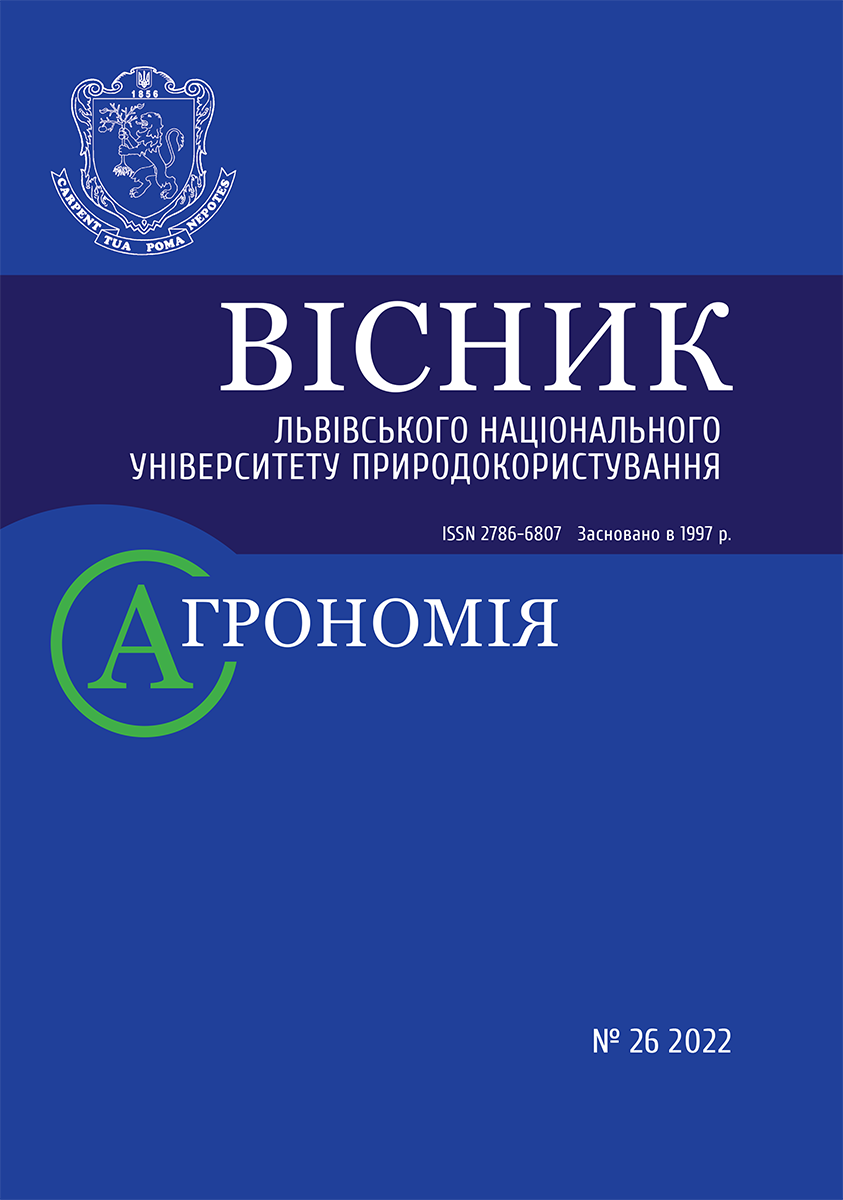PRODUCTIVITY OF AMARANT GRAIN DEPENDING ON THE VARIETY AND LEVELS OF FERTILIZER
DOI:
https://doi.org/10.31734/agronomy2022.26.077Keywords:
amaranth, variety, levels of fertilizer, yieldAbstract
Providing the population with food is of paramount strategic importance today. Solution of the problem of protein deficiency is possible through the efficient use of plant resources. Such crops include amaranth, the grain of which contains up to 20 % protein and up to 16 % oil. The uniqueness and value of amaranth oil is squalene, the content of which is about 8 %. To expand the cropping areas of amaranth in the western region of Ukraine, it is necessary to study and establish the most productive varieties for growing in conditions of sufficient moisture in the Western Forest-Steppe under the appropriate level of fertilizer.
According to research results, the grain yield of amaranth varieties was influenced by hydrothermal conditions of years of the research. Due to excessive rainfall combined with low temperatures in the first half of the growing season in 2020, the lowest yield was obtained, from 8.2 c/ha to 36.7 c/ha, depending on the level of fertilizer and the studied variety. It was found that the use of mineral fertilizers provided an increase in yield. On average, over the years of the research on the control variant, the yield in Ultra variety was 8.7 c/ha, while the application of mineral fertilizers at the rate of N120Р80К120 increased the grain yield by 11 c/ha. Depending on the level of fertilizer, the level of yield in Studentskyi variety was by 3.4–4.8 c/ha higher than the standard. The best yield indicators were provided by Kharkiv 1 variety: in the control variant – 23.1 c/ha, according to the norms N120Р80К120 – 40.4 c/ha, or 165.5 % and 105.1 % more than the standard.
In conditions of sufficient moisture of the Western Forest-Steppe on dark gray podzolic light loam soil, the highest grain yield among the studied varieties of amaranth was provided by Kharkiv 1variety: in the control variant – 23.1 c/ha and for fertilizers N120Р80К120 – 40.4 c/ha, which 165.5 and 105.1 % more than the Ultra variety (standard).
References
Amaranth: selection, genetics and prospects of cultivation : monograph / Hoptsiy T. I. etc. Kharkiv: HNAU. 2018. 362 p.
Krasnienkov S. V., Dudka M. I., Cherenkova T. P. Influence of mineral fertilizers on amaranth seed productivity. Feed and feed production. 2004. Vol. 53. P. 103–106.
Petrychenko V. F., Lykhochvor V. V. Plant growing. New technologies for growing field crops: a textbook. 5th ed., Corrected, supplemented. Lviv: Scientific and Production Enterprise «Ukrainian Technologies». 2021. P. 80.
Pulvento C., Lavini A., Riccardi M., D’Andria R., Ragab R. Assessing amarant hadaptability in a Mediterranean area of South Italy under different climatic scenarios. Irr. And Drain. 2015. No 64. P. 50–58.
Rakhmetov D., Rybalko J. Amaranth again reminds of himself. Propozycia. 2005. No 1. P. 52–53.
Rotich A. N., Gweyi-Onyango J. P., Korir N. K. Diagonal offset arrangement and spacing architecture effect on growth and yield components of grain amaranth in Kenya. Asian Res. J. Of Agric. 2017. No 6 (1). P. 1–8.
Savchuk O. I., Hurelia V. V., Koshytska N. A.& Black A. G. Efficiency of amaranth cultivation in the Polissya zone. Collection of scientific works Agro-industrial production of Polissya. 2016. Vol. 9. P. 36–39. URL: http://nbuv.gov.ua/UJRN/avpol_2016_9_9. (Accessed 06 December 2021).
State Register of Plant Varieties Suitable for Distribution in Ukraine for 2021. Р. 339. URL: https://minagro.gov.ua/storage/app/uploads/public/619/f7c/16b/619f7c16b87c8524959909.pdf (Accessed 06 December 2021).
Toader M., Ionescu A. M., Sonea C., Georgescu E. (2020). Research on the morphology, biology, productivity and yields quality of the Amaranthus cruentus L. in the southern part of Romania. Notulae Botanicae Horti Agrobotanici Cluj-Napoca. 2020. No 48 (3). P. 1413–1425.


